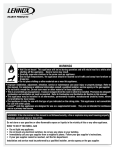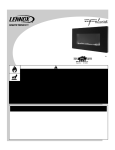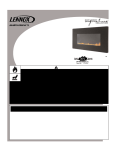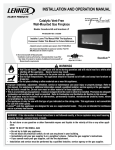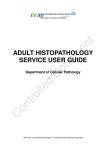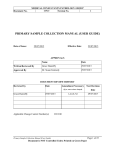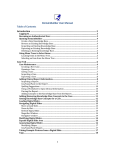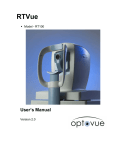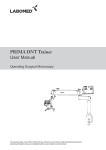Download OPHTHALMIC PATHOLOGY DIAGNOSTIC SERVICE USER GUIDE
Transcript
UCL INSTITUTE OF OPHTHALMOLOGY DEPARTMENT OF EYE PATHOLOGY OPHTHALMIC PATHOLOGY DIAGNOSTIC SERVICE USER GUIDE A Laboratory of the National Specialist Ophthalmic Pathology Service Version No 05 Effective Date 8 April 2013 Review Interval 2 yearly Author(s) Dr C Thaung, Prof P Luthert Authorised by: P Luthert, D Essex, E Caldwell Comment This issue replaces all previous versions of the „User Guide‟ _____________________________________________________________________________________________________ MG002: User Guide for the Ophthalmic Pathology Diagnostic Service, version 5 Effective Date: 08 April 2013 Page 1 of 14 CONTENTS: GLOSSARY/ABBREVIATIONS: ..................................................................................... 3 1. DEPARTMENT OVERVIEW ................................................................................... 4 2. HOW TO CONTACT US ......................................................................................... 4 2.1. Postal address..................................................................................................... 4 2.2. Laboratory Opening Times: ................................................................................. 5 2.3. Key Contacts ....................................................................................................... 5 3. HISTOPATHOLOGY: .............................................................................................. 6 INVESTIGATIONS AVAILABLE AND SPECIMEN REQUIREMENTS ............................ 6 3.1. Routine Histopathology ....................................................................................... 6 3.2. Fast Paraffin Processing ..................................................................................... 6 3.3. Unfixed Specimens ............................................................................................. 6 3.4. Histopathology Specimen Requirements ............................................................. 7 3.5. Urgent Specimens ............................................................................................... 7 4. CYTOLOGY: ........................................................................................................... 8 INVESTIGATIONS AVAILABLE AND SPECIMEN REQUIREMENTS ............................ 8 4.1. Cytology Investigations........................................................................................ 8 4.2. Cytology Specimen Requirements....................................................................... 8 5. HOW TO SUBMIT SPECIMENS FOR INVESTIGATION ........................................ 9 5.1. Request Forms and Sample Labelling ................................................................. 9 5.2. „HIGH RISK/DANGER OF INFECTION‟ SPECIMENS ....................................... 10 5.3. Specimen Containment ..................................................................................... 10 6. SPECIMEN TRANSPORTATION TO THE LABORATORY .................................. 10 6.1. Mailed or Couriered Specimens ........................................................................ 10 6.2. Users at Moorfields Eye Hospital ....................................................................... 10 7. RECEIPT OF SPECIMENS IN THE LABORATORY ............................................. 11 _____________________________________________________________________________________________________ MG002: User Guide for the Ophthalmic Pathology Diagnostic Service, version 5 Effective Date: 08 April 2013 Page 2 of 14 8. REPORTS ............................................................................................................ 11 8.1. Availability of Reports/Turnaround Times .......................................................... 11 8.2. Reports Database ............................................................................................. 11 8.3. Clinical Advice and Interpretation ...................................................................... 12 8.4. Time Limits for Requesting Additional Examinations ......................................... 12 9. USER SATISFACTION ......................................................................................... 12 10. NON-NHS SERVICES PROVIDED BY THE DEPARTMENT ............................ 13 10.1. Specimens from Private Patients ................................................................... 13 10.2. Research ....................................................................................................... 13 10.3. Training.......................................................................................................... 13 APPENDIX 1: AQUEOUS AND VITREOUS CYTOPATHOLOGY PROTOCOL FOR MOORFIELDS EYE HOSPITAL, CITY ROAD PATIENTS ........................................... 14 GLOSSARY/ABBREVIATIONS: DEP MEH NHS NSOPS Department of Eye Pathology Moorfields Eye Hospital National Health Service National Specialist Ophthalmic Pathology Service _____________________________________________________________________________________________________ MG002: User Guide for the Ophthalmic Pathology Diagnostic Service, version 5 Effective Date: 08 April 2013 Page 3 of 14 1. DEPARTMENT OVERVIEW 1.1. The Department of Eye Pathology in the UCL Institute of Ophthalmology provides a diagnostic service in ophthalmic histopathology and cytopathology. It is one of 4 laboratories within England making up the National Specialist Ophthalmic Pathology Service (NSOPS). 1.2. NSOPS laboratories were commissioned by the National Commissioning Group (now the Advisory Group for National Specialised Services) and are centrally funded. This means that NHS cases submitted to NSOPS laboratories for examination are seen without charge to the referring clinician. 1.3. This DEP is the largest ophthalmic pathology service within the UK and in 2010 dealt with 3000 diagnostic specimens. It aims to provide a high quality and timely service with provision of expertise in diagnosis by using an appropriate range of techniques including histology, histochemistry and immunohistochemistry. 1.4. The department consists of three consultant histopathologists (one full-time committed to diagnostic service and 2 part-time with other responsibilities), biomedical scientists and clerical staff. 1.5. The department is committed to the safe and secure handling and disposal of confidential information and accurately reporting results of investigations in a timely, confidential and clinically useful manner. 1.6. Material may be submitted elsewhere for techniques not performed within the department, such as PCR studies. However, such extra tests are not covered by the commissioning arrangement and will be charged to the referring clinician. 1.7. The department does not arrange or provide the following diagnostic laboratory services: microbiology, virology, immunology, haematology, biochemistry, immunofluorescence (including for pemphigoid) or advice on control of infection. 1.8. Electron microscopy is available within the UCL Institute of Ophthalmology as a research tool, but does not form part of the diagnostic service. 2. HOW TO CONTACT US The Department of Eye Pathology is situated on the first floor of the Cayton Street Building of the UCL Institute of Ophthalmology, Bath Street, London. 2.1. Postal address For correspondence and specimens: Department of Eye Pathology UCL Institute of Ophthalmology 11 - 43 Bath Street London EC1V 9EL United Kingdom _____________________________________________________________________________________________________ MG002: User Guide for the Ophthalmic Pathology Diagnostic Service, version 5 Effective Date: 08 April 2013 Page 4 of 14 2.2. Laboratory Opening Times: 0900 – 1700 hours Monday - Friday, excluding Public/Bank Holidays (England) and occasional UCL closure days. For notification of closure dates refer to https://eyepath.ucl.ac.uk/ NB: There is no out of hours or weekend service. 2.3. Key Contacts Fax No: 0207 608 6862 General Enquiries: Administrative Assistant Tel: 0207 608 6948 Email: [email protected] NB: Rapid paraffin bookings may be made on this telephone number. Technical Enquiries: Mr David Essex Laboratory Manager Tel: 0207 608 6888 Email: [email protected] NB: Notification concerning unfixed cytology specimens may be made on this telephone number. Clinical Enquiries: Dr Caroline Thaung Consultant Ophthalmic Pathologist Tel: 0207 608 6890 Email: [email protected] Head of Department: Professor Phil Luthert Consultant Ophthalmic Pathologist Tel: 0207 608 6808 Mobile: 07791 302 341 Email: [email protected] _____________________________________________________________________________________________________ MG002: User Guide for the Ophthalmic Pathology Diagnostic Service, version 5 Effective Date: 08 April 2013 Page 5 of 14 3. HISTOPATHOLOGY: INVESTIGATIONS AVAILABLE AND SPECIMEN REQUIREMENTS 3.1. Routine Histopathology 3.1.1. Histopathological examination of biopsy material, either diagnostic or excisional, of any tissue from the eye or its adnexal structures is available. 3.1.2. Guidance on which specimens should be submitted for examination may be found at: http://www.specialisedservices.nhs.uk/doc/10034 An expanded version of this document may be found at: http://www.rcophth.ac.uk/core/core_picker/download.asp?id=718&filetitle=Oc ular+Pathology+October+2010. 3.1.3. The choice of methodology and appropriateness of the investigation are at the discretion of the consultant pathologist who is guided by details on the clinical request form and knowledge of laboratory methods and current "best practice". 3.1.4. Ophthalmologists are free to discuss the methods employed for any given specimen, but the final decision remains a remit of the clinical pathologist. 3.2. Fast Paraffin Processing 3.2.1. In cases (usually eyelid tumour surgery) where a lesion is being excised, and subsequent reconstruction depends on knowledge of whether the margins are tumour free, a “fast paraffin” approach may be considered. 3.2.2. If the specimen can be delivered to the laboratory on the morning of the initial surgery, it can be processed overnight and an opinion will be available by midday on the next working day. 3.2.3. NB: This service is labour-intensive and must be booked in advance by telephoning 0207 608 6948 in order to ensure availability of both technical and consultant time on the required days. 3.3. Unfixed Specimens 3.3.1. There is currently no reason to submit unfixed histology specimens to the ophthalmic pathology laboratory. 3.3.2. Fresh material may be of use in investigation of neoplasia by molecular diagnostic methods, but this must be arranged with an appropriate laboratory by the referring clinician. 3.3.3. NB: In cases where sebaceous carcinoma is suspected, specimens should still be submitted in formalin. _____________________________________________________________________________________________________ MG002: User Guide for the Ophthalmic Pathology Diagnostic Service, version 5 Effective Date: 08 April 2013 Page 6 of 14 3.4. Histopathology Specimen Requirements 3.4.1. Histology specimens should be submitted in an appropriately sized leak-proof container containing standard tissue fixative (10% formalin). 3.4.2. No extraneous materials such as swabs, needles, tissues or papers should be placed in the specimen pot. 3.4.3. Specimens should reach the laboratory before 1500h for processing that day (fixation allowing). Specimens received after 1500h may not be processed until the following working day. 3.5. Urgent Specimens 3.5.1. It should be indicated on the request form if the specimen requires urgent attention. 3.5.2. It is recommended that specimens deemed to be urgent are received by the laboratory as early in the day as practicable and before 1500h. 3.5.3. A member of the laboratory staff should be informed prior to and on arrival of, the specimen. 3.5.4. If a report is required by a particular date, this should be indicated on the request form. An attempt will be made to accommodate these requests, but a final report by a particular date cannot be guaranteed. _____________________________________________________________________________________________________ MG002: User Guide for the Ophthalmic Pathology Diagnostic Service, version 5 Effective Date: 08 April 2013 Page 7 of 14 4. CYTOLOGY: INVESTIGATIONS AVAILABLE AND SPECIMEN REQUIREMENTS 4.1. Cytology Investigations 4.1.1. Cytology is the investigation of small samples of dispersed or dissociated cells and other tissue components devoid of natural tissue architecture. 4.1.2. Specimens for cytological investigations include surface impression cytology and cytology of fluid such as tears, aqueous, vitreous, or fluid from cystic lesions. 4.1.3. Cytological investigation provides a preliminary diagnostic impression and should not be regarded as providing a definitive diagnosis. 4.1.4. The practice of cytology is difficult and if there is uncertainty about its use in a particular case, it is preferable to discuss the case with the consultant pathologist prior to obtaining the specimen. 4.2. Cytology Specimen Requirements 4.2.1. Impression cytology discs should be submitted in a pot containing formalin in a manner similar to histology specimens. 4.2.2. Aspirates of fluids (eg vitreous) may be submitted fresh if it is possible to arrange immediate transport to the laboratory within working hours. The laboratory must be contacted in advance (preferably 1 working day) by telephoning 0207 608 6888 if a fresh specimen is to be submitted. Where this is not practicable, fixation of the specimen is recommended. 4.2.3. Small volume cytology specimens: the syringe used in the collection of the sample may be submitted with the fluid inside. Needles must be removed and the syringe capped. If the specimen is to be fixed, an equal volume of 10% formalin may be drawn up into the same syringe. Indication should be made on the request form as to whether the specimen is fixed or not. 4.2.4. If microbiological investigation is required, the requesting clinician must submit a separate specimen to an appropriate microbiology service. It is not possible for this laboratory to split a specimen under sterile conditions. 4.2.5. Users at Moorfields Eye Hospital wishing to submit aqueous or vitreous specimens for cytopathology should follow the current version of „Aqueous and Vitreous Cytopathology, Protocol for Moorfields Eye Hospital, City Road Patients‟ (refer to Appendix 1) and complete the aqueous/vitreous cytology request form on the reverse of the protocol. The protocol with request forms, together with specimen containers and self-seal specimen bags are available in the Moorfields operating theatres and Pathology Services. Please contact the laboratory if further supplies are required. _____________________________________________________________________________________________________ MG002: User Guide for the Ophthalmic Pathology Diagnostic Service, version 5 Effective Date: 08 April 2013 Page 8 of 14 5. HOW TO SUBMIT SPECIMENS FOR INVESTIGATION 5.1. Request Forms and Sample Labelling 5.1.1. For all specimens submitted to the laboratory, a fully completed request form MUST accompany each case. 5.1.2. You may use request forms provided by this department or by your own local histopathology department, as long as it is suitable for histopathology or cytology specimens. 5.1.3. Request forms are designed to provide: unique identification of the patient. a destination for the report and any charging information. the laboratory with the clinician contact details if discussion of the case is required. date and time of specimen collection/removal and investigations required (eg histology/cytology). type of specimen and anatomical site of origin clinical information so that the pathologist may handle the specimen appropriately and interpret microscopic findings in the proper context. an awareness of any health and safety issues with a given specimen. an indication if consent has been provided for research purposes. 5.1.4. With this in mind, please provide complete information on the request form. Failure to adequately complete any portion of a request form may lead to dangerous errors, the responsibility for which will lie with the referring ophthalmologist. 5.1.5. NB: The patient's NHS number should be stated (when applicable), as this provides a unique identifier, together with patient‟s first and last names, date of birth, gender, hospital number (if appropriate) and ethnicity. 5.1.6. Each specimen container, no matter how small, must also be labelled with the appropriate patient identification data (minimum of 3 identifiers eg first and last name, date of birth/age, gender and preferably patient‟s NHS/Hospital No). The information must be consistent with the request form, to prevent errors in specimen and patient identification. Multiple specimens from the same patient should also identify the specimen type/site. 5.1.7. If there are discrepancies between the request form and specimen labelling, specimens in inadequately labelled containers or accompanied by inadequately completed request forms; the requesting clinician will be required to complete the documentation in the DEP or the specimen may be returned to the referring clinician for proper completion, resulting in a delay in processing. _____________________________________________________________________________________________________ MG002: User Guide for the Ophthalmic Pathology Diagnostic Service, version 5 Effective Date: 08 April 2013 Page 9 of 14 5.2. „HIGH RISK/DANGER OF INFECTION‟ SPECIMENS 5.2.1. It is the responsibility of the requesting clinician to indicate on the REQUEST FORM AND SPECIMEN if the patient is known or suspected to be within a “High Risk/Danger of Infection” category (eg HIV, TB, Hepatitis B, Hepatitis C), to facilitate appropriate handling. 5.3. Specimen Containment 5.3.1. It is the responsibility of the referring clinical/surgical team to ensure that all specimens are submitted to the laboratory in suitable and approved containers. 5.3.2. Approved specimen containers have leak-proof lids and the appropriate hazard warning sign for the fixative eg formalin. 5.3.3. Ensure specimen containers are closed securely and placed inside a sealed specimen bag. 5.3.4. Specimens received leaking or damaged are a danger to all those who come into contact with them, including theatre staff, porters and laboratory staff. 5.3.5. Leakage from a specimen container may seriously compromise the diagnostic process. If a specimen is deemed unsuitable for safe processing by the laboratory staff, it will be disposed of and the requesting clinician informed of the problem as soon as is practicable. 6. SPECIMEN TRANSPORTATION TO THE LABORATORY 6.1. Mailed or Couriered Specimens 6.1.1. Specimens mailed or couriered should be packaged in approved containers and in accordance with the requirements of the delivery service. Hospitals more local to the department may make their own delivery arrangements via portering or delivery van services. 6.1.2. To confirm receipt of specimen(s) in the department, it is recommended that a „confirmation of receipt fax-back‟ form, providing the sender‟s confidential fax number, is enclosed with the specimen(s). 6.2. Users at Moorfields Eye Hospital 6.2.1. Moorfields Pathology Services is located within the hospital, and is not the same as the DEP, which is located within the UCL Institute of Ophthalmology. 6.2.2. All specimens submitted to the DEP from Moorfields should be sent via Moorfields Pathology Services so that accurate recording and tracking may be made. This includes specimens from private patients. 6.2.3. If a specimen is particularly urgent (for example, an unfixed vitreous biopsy), it is acceptable to leave a photocopy of the request form at Moorfields Pathology Services and to transport the specimen and the original form directly to the DEP. _____________________________________________________________________________________________________ MG002: User Guide for the Ophthalmic Pathology Diagnostic Service, version 5 Effective Date: 08 April 2013 Page 10 of 14 6.2.4. Moorfields Pathology Services is on telephone extension number 2166. Enquiries about histopathology and cytology reports for Moorfields patients may be made to this telephone number. 6.2.5. Specimen pots and request forms are available in the operating theatres and also to service users at Moorfields Eye Hospital from Moorfields Pathology Services. 7. RECEIPT OF SPECIMENS IN THE LABORATORY 7.1. A specimen does not become the responsibility of the DEP until it arrives at the specimen reception area within the DEP on the first floor of the UCL Institute of Ophthalmology. 7.2. Specimens should reach the laboratory before 1500h for processing that day (fixation allowing). Specimens received after 1500h may not be processed until the following working day. 7.3. It is therefore recommended that specimens deemed to be urgent, are delivered to the laboratory as early in the day as practicable and before 1500h. 7.4. On receipt, the request form and specimen are assigned a unique laboratory number which tracks the specimen throughout and is stated on the report. 8. REPORTS The department aims to provide a timely as well as a high quality service. 8.1. Availability of Reports/Turnaround Times 8.1.1. Target turnaround times (from specimen receipt to availability of an authorised report) are as follows: Small specimens: 5 working days Large specimens: 7 working days Complex specimens: 14 working days 8.1.2. However, it is not always possible to have a final report available within the above stated times. Complex cases may require a sequential series of special investigations, and in the case of referrals from elsewhere, time may be spent awaiting submission of further diagnostic material at our request. 8.1.3. If a report is required by a particular date, this should be indicated on the request form. An attempt will be made to accommodate these requests, but a final report by a particular date cannot be guaranteed. 8.2. Reports Database 8.2.1. It is possible for clinicians to access authorised reports for patients from their own hospital using the web-based pathology database administered by the DEP. This database can be accessed from anywhere, at any time, and is time efficient for both the clinician and the DEP. _____________________________________________________________________________________________________ MG002: User Guide for the Ophthalmic Pathology Diagnostic Service, version 5 Effective Date: 08 April 2013 Page 11 of 14 8.2.2. A registration process is required before reports can be accessed. Registration is done manually and may take a few days, so clinicians are recommended to register when they first start work in a new hospital. 8.2.3. The web address for the reports database is https://eyepath.ucl.ac.uk/ together with an on-line „Guide to Registering with EyePath‟ and „Guide to Using EyePath. 8.2.4. Unauthorised reports cannot be viewed on the database. Enquiries regarding unauthorised cases may be made to the pathology secretary on 0207 608 6948. 8.3. Clinical Advice and Interpretation 8.3.1. Advice to clinicians is readily available at all stages of the diagnostic process, from deciding what material to submit for examination to guidance on interpretation of the final report. 8.3.2. Please feel free to contact the reporting pathologist or one of the other consultants in the department for discussion of individual cases. 8.3.3. If discussing a report, please quote the Laboratory Number which appears on the report and uniquely identifies the patient and specimen. 8.4. Time Limits for Requesting Additional Examinations Paraffin wax blocks and stained slides are retained for a minimum of 10 years, should additional examinations be required. 9. USER SATISFACTION 9.1. It is our aim to continually provide, maintain and improve the services of our department so that they most suit the needs and requirements of our users and benefit patient care. 9.2. Feedback questionnaires are issued annually but, in the meantime, we appreciate any comments or suggestions that you consider would improve the quality of services provided. 9.3. Please contact our Quality Manager, Mrs Elizabeth Caldwell, with your comments. Email: [email protected] _____________________________________________________________________________________________________ MG002: User Guide for the Ophthalmic Pathology Diagnostic Service, version 5 Effective Date: 08 April 2013 Page 12 of 14 10. NON-NHS SERVICES PROVIDED BY THE DEPARTMENT 10.1. Specimens from Private Patients 10.1.1. The department accepts specimens from private patients, for which a charge will be made to the referring clinician. 10.1.2. A scale of charges and invoicing registration form is available from the departmental secretary on request. 10.1.3. NB: If the correct status of the patient (ie NHS or private) is not correctly declared, the requesting clinician may face penalties. 10.1.4. MEH: The request form accompanying such a specimen must clearly indicate that the specimen is from a private patient. 10.1.5. Users, other than MEH: A histopathology request form should be accompanied by a paper with the consulting room address (eg headed notepaper or a compliments slip) and including some reference (eg the patient's hospital number or initials) and requesting clinician‟s signature. 10.1.6. Alternatively, you may wish to make your histopathology examination request in the form of a referral letter on headed notepaper with the requesting clinician‟s signature. 10.2. Research 10.2.1. Being based in the UCL Institute of Ophthalmology, the ophthalmic pathology department is in an ideal position to provide services to support researchers. 10.2.2. Services can range from technical preparation of small numbers of slides to collaborative work with input from one or more consultant ophthalmic pathologists. 10.2.3. Please contact the department if you wish to discuss a project. 10.3. Training 10.3.1. Both ophthalmologists and histopathologists are welcome to spend time in the department if they wish to learn about ophthalmic pathology, either in preparation for examinations or in order to develop a subspecialist interest. 10.3.2. The department does not currently form part of any rotational training scheme, which allows training placements to be tailored to an individual in a flexible manner. 10.3.3. Please contact one of the consultant ophthalmic pathologists if you wish to arrange a training placement. _____________________________________________________________________________________________________ MG002: User Guide for the Ophthalmic Pathology Diagnostic Service, version 5 Effective Date: 08 April 2013 Page 13 of 14 APPENDIX 1: AQUEOUS AND VITREOUS CYTOPATHOLOGY PROTOCOL FOR MOORFIELDS EYE HOSPITAL, CITY ROAD PATIENTS A. Specimen Collection and Dispatch 1) If fresh specimens are to be sent, the laboratory should be informed preferably 1 working day prior to specimen collection; telephone 0207 608 6888. 2) Any fresh vitreous specimen needs to be received in the laboratory by 3pm at the latest if it is to be optimally processed. 3) A decision should be made at the time of the procedure as to whether the specimen should be split for Microbiology (classical or molecular, ie PCR for viruses) and Cytopathology. (Facilities do not exist for splitting of specimens within the Department of Eye Pathology.) 4) The specific „Aqueous/Vitreous Cytology‟ Request Form should be completed accurately and clearly, paying particular attention to identification of the referring Vitreoretinal (VR) surgeon and any Medical Retina / Paediatric team involved. If no alternate clinician is mentioned it will be assumed that the referring surgeon is responsible for ongoing management of the patient and that no-one else needs to be informed. 5) It is the responsibility of the clinician to indicate on the request form and specimen if the patient is known or suspected to be in a „High Risk/Danger of Infection‟ category. 6) Incomplete forms will be returned to the Lead Clinicians in VR and MR and no report will be issued until a completed form is received. 7) The specimen should be labeled accurately, clearly and be consistent with the request form. 8) The fresh cytopathology specimen should be brought directly from the hospital to the Department of Eye Pathology as swiftly as possible. This may include „neat‟ vitreous as well as the washings in a cassette. (Note that the latter cannot be used for classical microbiology.) 9) Any fresh microbiology specimen (if taken) should be sent for dispatch to Pathology Services within MEH. 10) HEALTH AND SAFETY IS CRITICAL WITH FRESH SPECIMENS: there must be no sharps included with the specimen eg needles; specimen containers must be leak-proof and securely closed to avoid specimen leakage; too often we receive specimens that are leaking. place the specimen in a self-seal specimen bag with absorbant material, sufficient to absorb any leakage; ensure there is appropriate sealing and packaging of the specimen to avoid breakage and to protect yourself, portering and laboratory staff. Ensure the request form accompanies the specimen. B. Laboratory 1) The fresh vitreous specimens will be processed according to the laboratory‟s current standard operating procedures. 2) Pathology Services at MEH will be informed of receipt of the specimen by FAX. (The request form will be faxed through.) 3) Where appropriate material will be sent to UCLH for clonality studies. (Note there is little scope for this with fixed specimens. Also note, the national funding for ophthalmic pathology does not include molecular pathology and the Trust will be billed directly for PCR studies.) 4) If there are likely to be significant delays (not uncommon given the complexity of the analysis of these specimens) either an initial report or a telephoned update will be issued. C. Formal Reporting Process 1) Authorised reports are immediately available electronically on eyepath.ucl.ac.uk 2) Printed reports are dispatched daily. With these reports, where the medical retina team is indicated, a report will go to them as well as to the VR surgeon involved. 3) We are happy to receive enquiries about unreported cases during laboratory hours. FT068, Vitreous Cytology Protocol and Request Form for Moorfields, version 1 Effective date: 01 March 2012 _____________________________________________________________________________________________________ MG002: User Guide for the Ophthalmic Pathology Diagnostic Service, version 5 Effective Date: 08 April 2013 Page 14 of 14














